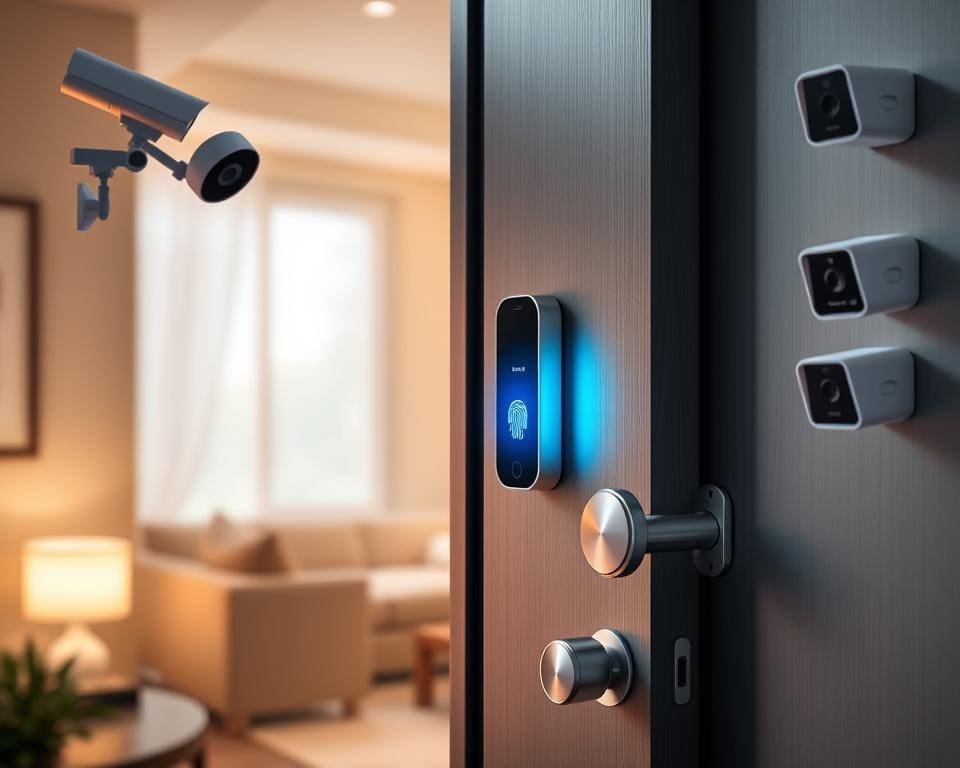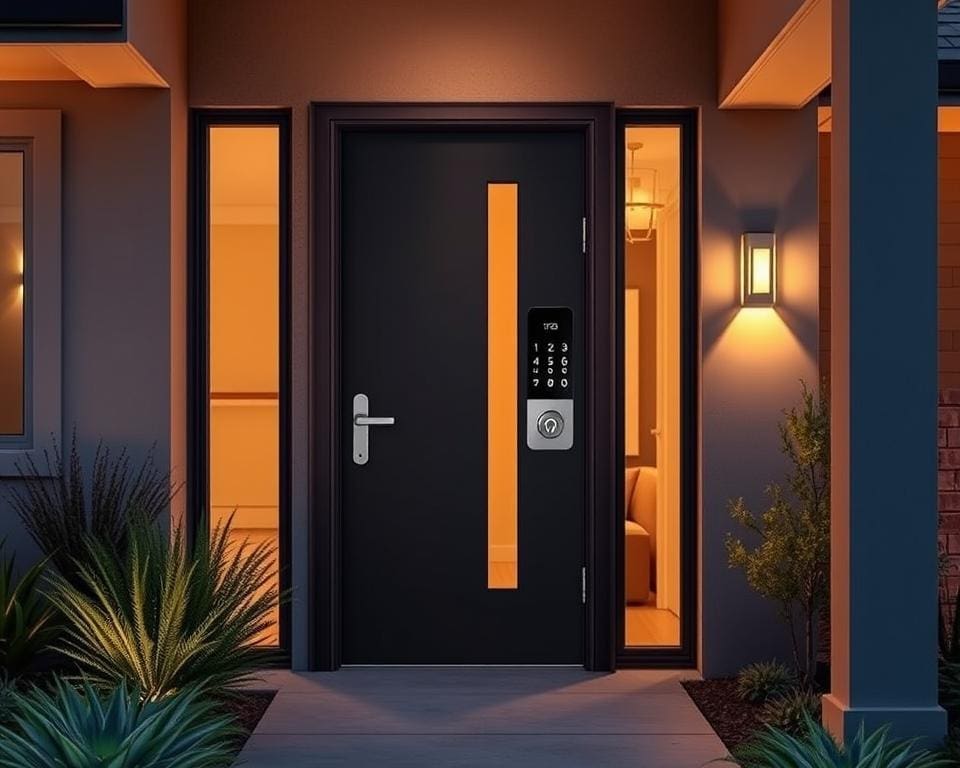In an era where security is paramount, smart locks with biometric access have emerged as a revolutionary solution in the landscape of high-tech home security. This cutting-edge technology addresses the increasing need for robust security systems by integrating unique identifiers, such as fingerprints, into everyday locking mechanisms. The biometric security system not only enhances safety but also offers an unparalleled convenience for homeowners.
By combining advanced technology with user-friendly features, these innovative locks provide a seamless entry experience. No longer reliant on traditional keys, homeowners can enjoy the peace of mind that comes with high-tech home security, making smart locks with biometric access a preferred choice for safeguarding properties.
Understanding Smart Lock Technology
Smart lock technology is revolutionising the way homeowners secure their properties. These innovative devices offer a seamless blend of convenience and advanced security features. Understanding what smart locks are, how they function, and the various types available can empower individuals to make informed decisions about their home security.
What Are Smart Locks?
Smart locks are electronic door locks designed for keyless entry systems, eliminating the need for traditional keys. Instead, these locks can be operated through smartphone apps, keypads, or even biometric recognition. Smart locks provide enhanced security by allowing homeowners to control access remotely, ensuring that their homes remain safe at all times.
How Do Smart Locks Work?
These electronic door locks utilise either Bluetooth or Wi-Fi technology to communicate with a user’s smartphone or other devices. When a homeowner wishes to gain access, they can unlock their door with a tap on their device. Smart locks can also be programmed to grant access to family members and friends via temporary codes, adding another layer of convenience.
Types of Smart Locks Available
Numerous types of smart locks are available on the market today, catering to various preferences and security needs. These include:
- Bluetooth-enabled locks: Operate within a short range and typically connect directly to a smartphone.
- Wi-Fi smart locks: Allow remote operation from anywhere with internet access, providing extensive monitoring capabilities.
- Keypad locks: Feature a numerical entry system, which provides a backup option for keyless entry.

Smart Locks with Biometric Access: High-Tech Home Security
Smart locks with biometric access represent a revolutionary step in the realm of high-tech home security. By employing sophisticated biometric security systems, these locks ensure that only authorised individuals can gain entry to your home. The technology behind fingerprint recognition is transforming the way homeowners approach security, offering unparalleled convenience and peace of mind.
The integration of biometric access in smart locks enhances not just security but also aids in monitoring home activity in real-time. Homeowners can receive immediate alerts about entry events, giving them the ability to manage access remotely. Such features prove essential for those who prioritise advanced security measures.
With rising concerns about traditional locking mechanisms, investing in smart locks with biometric access signifies a shift towards more secure living environments. As this technology continues to evolve, it will likely become a staple in modern home security solutions, emphasising its importance in safeguarding your loved ones and possessions.
Benefits of Biometric Security Systems
In an increasingly security-conscious world, biometric security systems have become a cornerstone of effective home protection. These advanced systems, particularly when integrated with smart locks with biometric access, offer several benefits that enhance both safety and convenience.
Enhanced Security Features
One of the most significant advantages of a biometric security system lies in its enhanced features. With capabilities to record access logs, homeowners receive detailed insights into who enters their property and when. This form of tracking proves invaluable, especially in identifying any unauthorised attempts to enter a home. Additionally, smart locks with biometric access can be programmed to deny entry based on preset criteria, significantly improving home safety.
Convenience of Keyless Entry
The convenience provided by a keyless entry system is unparalleled. Homeowners can grant access to family members without the need for physical keys, effectively reducing the anxiety associated with lost or duplicated keys. This system eliminates the need for remembering complex codes or carrying key fobs. The simplicity of biometric technology ensures that entry is streamlined, making it not just secure but also user-friendly for everyone in the household.
As you consider upgrading your home security, exploring options such as biometric security systems offers a promising path toward a safer living environment.
How Biometric Access Works in Smart Locks
Understanding the mechanics behind biometric access is vital for anyone considering the benefits of electronic door locks. This technology enhances security by employing various unique identifiers to control access, with fingerprint recognition technology being one of the most prominent methods.
Fingerprint Recognition Technology
Fingerprint door locks utilise advanced sensors that scan and analyse the unique patterns and ridges of an individual’s fingerprint. Upon verification, access is granted, providing a seamless experience. This method stands out due to its reliability and low false acceptance rates. The data stored in these systems is encrypted to ensure that sensitive information is protected from breaches. Implementing strong encryption techniques, such as those outlined in the Advanced Encryption Standard, further reinforces data security within these smart locks.
Other Biometric Options
Besides fingerprint recognition, various other biometric access methods are available. Options like facial recognition and iris scanning provide unique alternatives, each with specific advantages. Facial recognition systems analyse key features of a person’s face, while iris scanning focuses on the intricate patterns in the eye. These methods expand the range of security options for electronic door locks, appealing to those seeking a tailored approach to home security.
Installation and Integration with Smart Home Devices
Installing smart locks with biometric access is not just about enhancing security. This process paves the way for seamless home automation with biometric access, boosting convenience and efficiency in daily routines. Understanding the necessary steps for a successful installation can make this upgrade a rewarding endeavour.
Steps to Install a Smart Lock
The installation of smart locks requires careful attention to detail. Follow these steps to ensure a smooth process:
- Assess the compatibility of your door with the desired smart lock model.
- Remove existing hardware, ensuring not to damage the door.
- Follow the manufacturer’s specific instructions for installation.
- Connect your smart lock to your Wi-Fi network, if applicable.
- Test the lock to confirm it is functioning properly.
Compatibility with Home Automation Systems
Smart locks are designed to integrate with various smart home devices, enhancing your home’s functionality. Many brands offer compatibility with popular platforms such as Amazon Alexa or Google Assistant. This integration allows for remote access and monitoring, providing users with an added layer of convenience.
For a well-rounded approach to home design, consider the latest interior design trends that complement the installation of smart locks, creating unique living spaces that reflect personal style.
Choosing the Right Smart Lock for Your Home
Selecting the perfect smart lock is essential for ensuring the security of your home. By considering various factors, you can make an informed decision that suits your needs. Think about the security features and compatibility with your existing smart home devices. Ease of use is equally important, especially for family members who may not be tech-savvy.
Factors to Consider
When choosing a smart lock, pay attention to the following aspects:
- Security Features: Look for locks with advanced encryption and biometric access options for enhanced safety.
- Compatibility: Ensure that the smart lock integrates seamlessly with your current smart home ecosystem.
- Ease of Installation: Consider models that offer quick and easy installation processes.
- Battery Life: Evaluate the longevity of batteries and features that notify users when power is low.
- User Interface: Opt for easy-to-use apps or interfaces for managing access and settings.
Top Brands and Models
Several top brands in the market offer smart locks with biometric access, making them a prominent choice for modern homeowners:
- August Smart Lock Pro: Known for its flexible installation and great compatibility with smart home devices.
- Yale Linus Smart Lock: Features robust security options and user-friendly access management.
- Ultraloq U-Bolt Pro: Combines fingerprint recognition technology with a durable design for added peace of mind.
Maintaining Your Smart Lock with Biometric Access
To ensure your smart lock with biometric access operates flawlessly, a structured maintenance routine is essential. Users should prioritise firmware updates to bolster security and enhance functionality. Regular checks and specific troubleshooting tips can minimise potential issues.
Regular Updates and Upgrades
Maintaining smart locks requires consistent updates to the device’s firmware. These updates not only provide critical security patches but also introduce new features that enhance the user experience. Downloading updates promptly is crucial for safeguarding against vulnerabilities. Additionally, verify compatibility with your home automation systems during upgrades to ensure seamless operation.
Troubleshooting Common Issues
Even the most advanced smart locks may encounter issues. Effective troubleshooting smart locks involves a few straightforward techniques. If the lock fails to recognise a fingerprint, clean the biometric sensor gently to remove any debris. In cases of connectivity problems, check the Wi-Fi signal strength and ensure your smart lock is within range. Regular checks on battery levels will prevent unexpected failures, allowing for smooth biometric access maintenance.
Future Trends in Smart Lock Technology
As we look towards the future of smart locks, significant advancements in biometric security are on the horizon. Innovations are set to enhance user authentication methods through advanced artificial intelligence, which will not only streamline access but also improve overall safety. These cutting-edge developments hint at a new era where security becomes more personalised, allowing homeowners to tailor their smart locks to better suit individual needs.
Moreover, the implementation of more robust encryption methods promises to further protect user data from potential breaches, reflecting the growing concern for cybersecurity in the realm of smart home technology trends. With increasing demands for interconnected systems, smart locks will be designed to seamlessly integrate with other home automation devices, creating a harmonious and secure living environment.
In this evolving landscape, the future of smart locks is also likely to embrace user-friendly interfaces, making it simpler for individuals to manage their home’s security. As consumer preferences shift towards multifunctional devices, we can expect an exciting range of biometric security options that resonate with the lifestyle demands of today’s homeowners. For further insights into technology advancements, consider exploring the relationship between different smart devices by visiting smart home technology trends.









